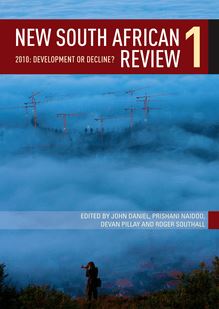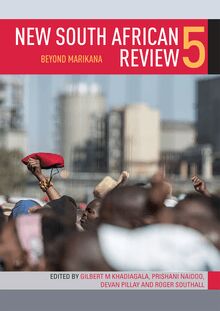New South African Review 5 , livre ebook
212
pages
English
Ebooks
2015
Vous pourrez modifier la taille du texte de cet ouvrage
Obtenez un accès à la bibliothèque pour le consulter en ligne En savoir plus
Découvre YouScribe en t'inscrivant gratuitement
Découvre YouScribe en t'inscrivant gratuitement
212
pages
English
Ebooks
2015
Vous pourrez modifier la taille du texte de cet ouvrage
Obtenez un accès à la bibliothèque pour le consulter en ligne En savoir plus
Publié par
Date de parution
01 novembre 2015
Nombre de lectures
0
EAN13
9781868148752
Langue
English
Introduction : Political reconfigurations in the wake of Marikana - Prishani Naidoo
Part One
Chapter 1: Reconstituting and re-imagining the left after Marikana - Noor Nieftagodien
Chapter 2: Labour and community struggles 1994-2014 - Marcel Paret
Chapter 3: Half full or half empty? The Numsa moments and the prospects of left revitalisation - Devan Pillay
Introduction to Part Two - Devan Pillay
Chapter 4: The South African economy: The minerals-energy-finance complex redubbed? - Samantha Ashman
Chapter 5: Between a rock and a hard place: State-business relations in the mining sector 86 - Ross Harvey
Chapter 6: The platinum belt strike wave: Breakdown in the institutionalisation of industrial conflict - Crispen Chinguno
Chapter 7: When gold mining ends: An environmental catastrophe for Johannesburg? - Anthony Turton
Introduction to Part Three - Roger Southall
Chapter 8: Constitutionalism: An ‘unqualified human good’? - Pierre de Vos
Chapter 9: People’s Parliament? Do citizens influence South Africa’s legislatures? - Samantha Waterhouse
Chapter 10: Corruption - Ivor Sarakinsky
Chapter 11: Marikana and the politics of public order policing - Monique Marks and David Bruce
Chapter 12: ‘In December we are rich, in January we are poor’: Consumption, saving, stealing and insecurity in the kasi - David Dickinson
Introduction to Part Four - Gilbert M Khadiagala
Chapter 13: The evolution of South Africa’s foreign policy - Garth le Pere
Chapter 14: South Africa, the BRICS and human rights: In bad company? - Karen Smith
Chapter 15: Trading with the frenemy: How South Africa depends on African trade - Rod Alence
Publié par
Date de parution
01 novembre 2015
Nombre de lectures
0
EAN13
9781868148752
Langue
English
Contents Preface ix Introduction: Political reconfigurations in the wake of Marikana 1 Prishani Naidoo Part 1: New Political Directions? 17 Chapter 1: Reconstituting and re-imagining the left after Marikana 18 Noor Nieftagodien Chapter 2: Labour and community struggles 1994-2014 34 Marcel Paret Chapter 3: Half full or half empty? The Numsa moments and the prospects of left revitalisation 48 Devan Pillay Part 2: Economy, Ecology and Labour 63 Introduction to Part 2 64 Devan Pillay Chapter 4: The South African economy: The minerals-energy-finance complex redubbed? 67 Samantha Ashman Chapter 5: Between a rock and a hard place: State-business relations in the mining sector 86 Ross Harvey Chapter 6: The platinum belt strike wave: Breakdown in the institutionalisation of industrial conflict 104 Crispen Chinguno Chapter 7: When gold mining ends: An environmental catastrophe for Johannesburg? 120 Anthony Turton Part 3: State and Society 143 Introduction to Part 3 144 Roger Southall Chapter 8: Constitutionalism: An unqualified human good ? 151 Pierre de Vos Chapter 9: People s Parliament? Do citizens influence South Africa s legislatures? 171 Samantha Waterhouse Chapter 10: Corruption 188 Ivor Sarakinsky Chapter 11: Marikana and the politics of public order policing 207 Monique Marks and David Bruce Chapter 12: In December we are rich, in January we are poor : Consumption, saving, stealing and insecurity in the kasi 229 David Dickinson Part 4: South Africa in the International Arena 245 Introduction to Part 4 246 Gilbert M Khadiagala Chapter 13: The evolution of South Africa s foreign policy 249 Garth le Pere Chapter 14: South Africa, the BRICS and human rights: In bad company? 268 Karen Smith Chapter 15: Trading with the frenemy: How South Africa depends on African trade 284 Rod Alence Contributors 298 Index 299
NEW SOUTH AFRICAN REVIEW 5
BEYOND MARIKANA
EDITED BY GILBERT M KHADIAGALA, PRISHANI NAIDOO, DEVAN PILLAY AND ROGER SOUTHALL
Published in South Africa by:
Wits University Press
1 Jan Smuts Avenue
Johannesburg
www.witspress.co.za
Published edition Wits University Press 2015
Compilation Edition editors 2015
Chapters Individual contributors 2015
First published 2015
Also available in digital formats
ISBN 978-1-86814-874-5(print)
ISBN 978-1-86814-877-6 (PDF)
All rights reserved. No part of this publication may be reproduced, stored in a retrieval system, or transmitted in any form or by any means, electronic, mechanical, photocopying, recording or otherwise, without the written permission of the publisher, except in accordance with the provisions of the Copyright Act, Act 98 of 1978.
Project managed by Monica Seeber
Cover photograph Mujahid Safodien
Cover design and layout by Hothouse South Africa
Printed and bound by Interpak Books
Preface
Beyond Marikana , the fifth edition of the New South African Review , continues to present informed, scholarly discussion and debate about key issues animating the South African experience. Produced between January 2014 and May 2015, this particular volume was shaped largely around the contention that there are significant political shifts underway in South Africa today, with several chapters tracing their fault lines to the 2012 massacre by police of striking mineworkers in a place called Marikana.
Although the third volume in the New South African Review series offered an analysis and critique of the various forces immediately implicated in the tragedy associated with Marikana, it could not have anticipated the kinds of political ructions that we have since witnessed, especially from within different parts of the African National Congress (ANC) Alliance. The fifth volume once again, then, consciously draws attention to Marikana, but this time asking what its effects and affects have been, and why it has had such an impact. In this way, Marikana becomes the starting point for a much broader discussion and debate about the potential for new political alliances and forms to emerge in the current context, a discussion that resonates globally in the wake of the political experiments of movements, such as Occupy Tahrir, Occupy Wall Street and the Spanish Indignados, and will hopefully continue in editions to come.
New South African Review 5 also offers close analyses of contemporary developments with regard to other aspects of, and issues affecting, South African society - including corruption, the economy, the Constitution, and uranium poisoning as a by-product of the mining industry.
This volume would not have been possible without the generosity of all its authors, to whom we are extremely grateful. Thanks must also go to the team at Wits University Press who continue to provide excellent guidance, assistance, skill and support to us as editors, and ensure that there is a final product for us to share. Particular thanks to the Dean of Humanities, Professor Ruksana Osman; Head of the School of Social Studies, Professor Shahid Vawda; and the Strategic Planning and Allocation of Resources Committee (Sparc) Fund for their ongoing support of the New South African Review .
Gilbert M Khadiagala, Prishani Naidoo, Devan Pillay and Roger Southall
May 2015
INTRODUCTION: Political reconfigurations in the wake of Marikana
Prishani Naidoo
On the weekend of 13-14 December 2014, two significant political events took place in South Africa. At a hotel in Kempton Park near Johannesburg, a national people s assembly was convened by unionists from the National Union of Metalworkers of South Africa (Numsa) together with other activists (both independent and from a range of political formations), in preparation for the launch of the United Front. At the University of the Free State in Mangaung, the Economic Freedom Fighters (EFF) held what it also billed as its first national people s assembly . Both groups had emerged from dissatisfaction among Alliance members with the current leadership of the African National Congress (ANC). Both events borrowed, in the idea of the assembly , from the history of the struggle against apartheid and from contemporary experiments of collectives fighting against the various effects and manifestations of neoliberal policies around the world. It could, then, be argued that together they reflect a growing and deepening disappointment with, and critique of, existing political forms and practices that pass for democracy in South Africa today, and a desire for alternative ways of engaging collectively around common interests, needs and aspirations.
As I sat in the sea of yellow t-shirts in the Kempton Park assembly listening to presentations and discussions, 1 fellow participants connected to social media kept me abreast of proceedings in Mangaung. Although there was so much familiar and similar about what was unfolding in both spaces, there was also a profound sense that something new was afoot, that something different could be underway. Sitting in the same room in Kempton Park were activists who just a few years ago had been on opposing sides of earlier divides within, and splits from, different parts of the Congress Alliance. 2 Mangaung was also celebrating the first real mass exodus of young people from the ANC fold since 1994. They were coming together with other youth fed up with the limited choices available to them in their lives, to commit themselves to the building of a political alternative to the ANC.
For many of us, who had been part of earlier collectives that had mounted critiques of (and experimented with alternatives to) the ANC government s neoliberal trajectory since the 1990s, this could not be cynically written off as d j vu , as a much greater mass of people were beginning to find each other as comrades again, in a new cycle of struggle - a new cycle that, as this Introduction and several chapters in this volume argue, finds its roots in the events that have come to be known as Marikana .
Almost three years have passed since the massacre of thirty-four striking mineworkers at Marikana by the South African police, and yet the event continues to hold profound significance in the political realm, the depth of its influences and effects perhaps only beginning to be felt and understood today. In August 2012, the name Marikana became etched in history and memory as a symbol of the willingness of the state to use brutal force against workers in protecting the interests of capital - and of an uncompromising spirit of resistance (or refusal to concede) to the impositions of such power.
As images of the bloodshed flashed across television screens and newspapers, South Africans across the political spectrum were moved. In the first instance, as the starkness of the inequalities and dangers borne by Lonmin workers in sustaining South Africa s richest economic sector (platinum) was revealed, moral outrage was expressed in various forms of public critique of the ANC, its leaders, Lonmin s management and directors, and the police - and in acts of solidarity and support for the communities affected by the massacre and its aftermath. The Introduction to New South African Review 3 provided one such critique, highlighting the contradictions within the ruling party and its Alliance, as well as among its leadership, made visible and undeniable by Marikana.
But beyond its laying bare of certain unmistakable facts about the life of the poor in post-apartheid South Africa and about the ANC, its leaders, big capital (and where their interests overlap), three years later why does Marikana continue to feature so prominently in our political engagements? And has it shaped contemporary approaches to politics in ways that hold the potential for new political imaginaries and practices to emerge?
As several chapters in this volume show, the events of August 2012 in Marikana produced significant shifts in the ruling party and its Tripartite Alliance, and can be seen to represent a questioning (and a failure) of corporatist frameworks of engagement th





